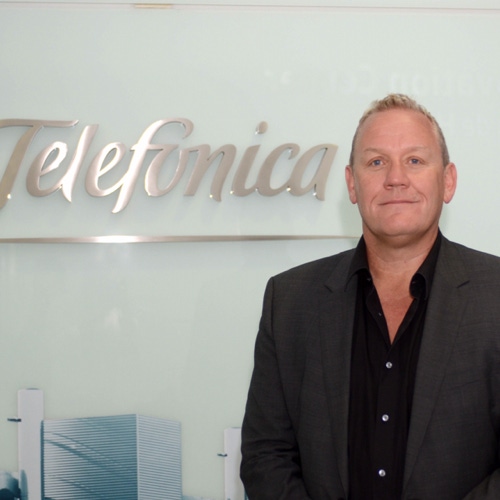Telefónica Group CIO: Using cloud to regain ground lost to OTT players
With operations in 24 countries, over 120,000 employees globally, Telefónica Group, one of the largest telecommunications companies in the world, is looking to put at IT at the core of everything that it does in order to compete globally in an industry currently in the throes of a digital revolution. Phil Jordan, group chief information officer at Telefónica says that cloud is at the centre of how the company plans to regain terrain lost to over-the-top (OTT) players, make its core mobile and fixed line operations more flexible and scalable, and enable it to provide next generation digital services.
August 29, 2014

With operations in 24 countries, over 120,000 employees globally, Telefónica Group, one of the largest telecommunications companies in the world, is looking to put at IT at the core of everything that it does in order to compete globally in an industry currently in the throes of a digital revolution. Phil Jordan, group chief information officer at Telefónica says that cloud is at the centre of how the company plans to regain terrain lost to over-the-top (OTT) players, make its core mobile and fixed line operations more flexible and scalable, and enable it to provide next generation digital services.
“IT is a strategic differentiator for the company, but it hasn’t always been perceived that way, even when I became CIO,” says Jordan, who took up his current role at Telefónica in 2011. Context, he says, is essential to understanding why this perception proliferated within the company and throughout the telecoms sector more broadly, and why the operator is currently spearheading so many new digital initiatives.
“We’re a business operating in an industry that failed to innovate fast enough, which has probably created the opportunity for the Vibers and the WhatsApps of the world, and I think we’ve failed to innovate in our own product because, like a lot of businesses, we felt we didn’t need to because we were making lots of money,” he explains. “You get complacent.”
The situation is cause for concern, not just at Telefónica but for most telcos, which could be losing up to $386bn cumulatively by 2018 to OTT players like Skype and WhatsApp according to research and consulting firm Ovum.
It is within this context that Telefónica has sought to become more digital, an effort complicated by its continued growth and a series of acquisitions. As one of the biggest and oldest telcos with lots of fixed line heritage, it has accumulated a very complex IT systems landscape over the years, which Jordan says the company is constantly trying to simplify.
“One of our big challenges as a federation of separate businesses is that we have to remove complexity. We’ve managed to overcomplicate the industry, our business, and our internal systems over the last 20 years,” he says.
But the biggest challenge, he explains, is inextricably linked to what Jordan believes is the biggest opportunity for the operator: data.
“We’ve always had a tremendous amount of data, we’ve always been a big data company, but how do you derive insights from the data? Because of systems fragmentation, we’ve struggled to derive real insight and particularly global insight through the use of data. Getting a 360 degree view of our customers is actually a much bigger challenge for us than working out how to leverage analytics and big data systems.”
Driving core platforms and systems change at Telefónica
Because of the way the industry grew, Jordan explains, the lack of recognition in how important IT was moving forward, “we’ve ended up with such fragmented systems that they don’t really lend themselves well to forming that 360 degree customer view. But that’s a problem because data is the new battleground and the future differentiator for our industry.”
“We’ve gone from having almost 7,000 systems three years ago, down to 4,200 now, so we’re slowly simplifying our estate.”
The company’s SaaS and virtualisation strategies are central to this process. Telefónica is a large user of Office 365, SAP SuccessFactors and Salesforce among other big name cloud services. It deploys these services from a private cloud platform hosted in its massive datacentre in Spain, which at a whopping 65,700 m2 is one of the largest in Europe, dwarfed only by Portugal Telecom’s recently announced Covilha datacentre.
By centralising these services the company is able to leverage its cloud platform and generate operational efficiencies through a shared services approach, while ensuring local standards and businesses processes can be maintained where necessary, and by purchasing commoditised solutions off-the-shelf the company has enjoyed significant cost benefits.
The operator has also virtualised a number of its internal platforms, which allows the company to sweat its existing assets and make its datacentre resources more scalable and flexible.
By the end of this year Jordan’s team will have virtualised about 40 per cent of the group’s IT servers, and the company is now taking this approach to the most mission-critical system of all – the core network, through network function virtualisation (NFV). Along with global CTO Enrique Blanco and his team the company is working on a proof of concept for a virtual radio access network (vRAN). Work on a virtual Evolved Packet Core, vIMS, vDNS and vDHCP is also set to conclude this year as the operator looks tovirtualise 30 per cent of all new infrastructure by 2016.
Virtualising these system will allow Telefónica to deploy network assets in a way that allows them to be managed centrally and deployed globally, while making them more flexible, scalable and less expensive to acquire and maintain than legacy networking hardware.
The operator has taken a slightly different approach with its business support and operational support systems. Telefónica recognises the need to transform BSS and OSS in order to have these digital capabilities and a foundation for the future. But it’s not consolidating these systems or putting one BSS or OSS across the group because it’s just not practical or doable across many group companies, Jordan explains.
“We are doing greenfield BSS implementations in 14 separate countries at the moment, so we’ve accelerated beyond belief in pace and the urgency, and these are with the same standard processes and architecture, using three different vendors, heavily based on standards and reused on processes. So core BSS and OSS processes reused country to country, in clusters of the same technology.”
The company’s multimillion dollar investment into its global BSS overhaul has as much to do with eliminating data systems fragmentation and simplifying the back-end of the services it offers as much as driving digital engagement with customers and readying itself for the company’s future, which Jordan says increasingly sees digital services at its core.
“We must become more digital in our interactions with our customers. The new generation of Telefónica customers don’t engage with us in the way they used to. Online is an important channel for us but a ‘digital only’ channel experience needs to be created in all the countries we operate in.”
But Jordan says this is part of a broader strategy to drive digital services – particularly platform-based services – within Telefónica, and as a key component of its market offerings.
“I don’t think we’ll ever be able to innovate as fast as the model that now exists around the internet and around the digital world, so adopting an open platform that innovators and entrepreneurs want to base their applications and their services on, and provide capabilities to innovate with, is central to where we want to go, and becoming a platform business, offering platform as a service, is a key element to our future.”
Where Telefónica is heading
The company’s transformation into one primarily focused on digital services hasn’t been easy, but it has made some bold changes to encourage its move in that direction, beyond what’s already been discussed above of course.
Telefónica Digital for instance, the London-headquartered independent division of the telco dealing primarily in digital services and data-driven marketing innovations, was closed down and re-integrated into the company in February this year. The move was aimed at cutting costs, but it was also intended to centralise the type of work it was doing back in Madrid, the company’s headquarters, and weave the ‘digital-first’ approach into the broader group rather than keep it at arm’s length.
Jordan says that there is no longer any doubt of the convergence of IT and telecoms, both in terms of the players competing to offer digital (cloud) services, and the technologies at their foundation. The company is going to continue working towards the virtualisation of its network, having recently announced a partnership with Brocade to explore the capabilities of virtualised network appliances running on standard, x86 Intel-based hardware.
These kinds of innovations are central to the company’s strategy of simplifying and improving the scalability and flexibility of its network, particularly as it looks to target the Internet of Things.
“We see the opportunity for monetising data on networks through wearables. It allows us to sweat the assets, and M2M is a great way to schedule data outside human peaks. It’s a great way to optimise our own networks, and we also want to build services around IoT. All these devices that will be embedded will need to talk to one another,” he says.
“We need to build and aggregate services around this. But we need to monetise it because it’s expensive to build networks at a time when these services are commoditised and easily disrupted by other people. It’s a good challenge.”
Jordan says that in terms of internal systems, what really excites him is wearables. He would like to see how the company could make use of wearable devices and cloud services in combination at Telefónica, particularly for field service engineers. It could help make their jobs safer, and help them work more efficiently.
He explains that if he had the choice to start from scratch and greenfield everything, he would put as much emphasis on the telecoms business model itself as the systems that help it run, though he admits this is more of a distant fantasy than anything.
“My greenfield dream would be: don’t run twenty countries as independent companies; don’t engage with independent regulators in each country. I think it could be radically simplified. Rather than 7,000 systems I think a group telco should be able to run on around 100,” he says, adding that only then will telcos truly be able to keep up with OTT players.
“Imagine the agility and pace that you would gain if you could run on 100 systems. We still have mainframe in Telefónica.”
This article originally appeared on our sister site, Business Cloud News
Read more about:
DiscussionAbout the Author(s)
You May Also Like











_1.jpg?width=300&auto=webp&quality=80&disable=upscale)


.png?width=800&auto=webp&quality=80&disable=upscale)